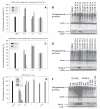A novel dithiocarbamate analogue with potentially decreased ALDH inhibition has copper-dependent proteasome-inhibitory and apoptosis-inducing activity in human breast cancer cells
- PMID: 21035945
- PMCID: PMC3671753
- DOI: 10.1016/j.canlet.2010.09.010
A novel dithiocarbamate analogue with potentially decreased ALDH inhibition has copper-dependent proteasome-inhibitory and apoptosis-inducing activity in human breast cancer cells
Abstract
Dithiocarbamates are a class of sulfur-based metal-chelating compounds with various applications in medicine. We reported previously that certain members of dithiocarbamates, such as diethyldithiocarbamate, disulfiram (DSF) and pyrrolidine dithiocarbamate (PDTC), were able to bind with tumor cellular copper to inhibit tumor growth through the inhibition of proteasome activity and induction of cancer cell apoptosis. Since the DSF is an irreversible inhibitor of aldehyde dehydrogenase (ALDH), its ALDH-inhibitory activity might potentially affect its usefulness as an anti-cancer drug. For the purpose of selecting potent anti-cancer compounds that are not ALDH inhibitors and mapping out preliminary structure-activity relationship trends for these novel compounds, we synthesized a series of PDTC analogues and chose three novel compounds to study their ALDH-inhibitory activity, proteasome-inhibitory activity as well as the cancer cell apoptosis-inducing activity. The results showed that compared to DSF, compound 9 has less ALDH inhibition activity, and the in vitro results also proved the positive effects of 9-Cu in proteasome inhibition and apoptosis induction in breast cancer cells, suggesting that 9 as a lead compound could be developed into a novel proteasome inhibitor anti-cancer drug.
Copyright © 2010 Elsevier Ireland Ltd. All rights reserved.
Figures






Similar articles
-
Evaluation of copper-dependent proteasome-inhibitory and apoptosis-inducing activities of novel pyrrolidine dithiocarbamate analogues.Int J Mol Med. 2007 Dec;20(6):919-25. Int J Mol Med. 2007. PMID: 17982703
-
Clioquinol and pyrrolidine dithiocarbamate complex with copper to form proteasome inhibitors and apoptosis inducers in human breast cancer cells.Breast Cancer Res. 2005;7(6):R897-908. doi: 10.1186/bcr1322. Epub 2005 Sep 20. Breast Cancer Res. 2005. PMID: 16280039 Free PMC article.
-
Inhibition of prostate cancer cellular proteasome activity by a pyrrolidine dithiocarbamate-copper complex is associated with suppression of proliferation and induction of apoptosis.Front Biosci. 2005 Sep 1;10:2932-9. doi: 10.2741/1749. Front Biosci. 2005. PMID: 15970547 Review.
-
Fetal bovine serum requirement for pyrrolidine dithiocarbamate-induced apoptotic cell death of MCF-7 breast tumor cells.Eur J Pharmacol. 2010 Dec 15;649(1-3):135-9. doi: 10.1016/j.ejphar.2010.09.048. Epub 2010 Sep 22. Eur J Pharmacol. 2010. PMID: 20868670
-
Copper-binding compounds as proteasome inhibitors and apoptosis inducers in human cancer.Front Biosci. 2007 Jan 1;12:135-44. doi: 10.2741/2054. Front Biosci. 2007. PMID: 17127289 Review.
Cited by
-
Iron and Copper Intracellular Chelation as an Anticancer Drug Strategy.Inorganics (Basel). 2018;6(4):126. doi: 10.3390/inorganics6040126. Epub 2018 Nov 30. Inorganics (Basel). 2018. PMID: 33912613 Free PMC article.
-
Aldehyde dehydrogenase inhibitors: a comprehensive review of the pharmacology, mechanism of action, substrate specificity, and clinical application.Pharmacol Rev. 2012 Jul;64(3):520-39. doi: 10.1124/pr.111.005538. Epub 2012 Apr 27. Pharmacol Rev. 2012. PMID: 22544865 Free PMC article. Review.
-
Reversing the intractable nature of pancreatic cancer by selectively targeting ALDH-high, therapy-resistant cancer cells.PLoS One. 2013 Oct 23;8(10):e78130. doi: 10.1371/journal.pone.0078130. eCollection 2013. PLoS One. 2013. PMID: 24194908 Free PMC article.
-
Association of metals and proteasome activity in erythrocytes of prostate cancer patients and controls.Biol Trace Elem Res. 2012 Oct;149(1):5-9. doi: 10.1007/s12011-012-9391-z. Epub 2012 Mar 16. Biol Trace Elem Res. 2012. PMID: 22422614 Free PMC article.
-
Advances in omics-based methods to identify novel targets for malaria and other parasitic protozoan infections.Genome Med. 2019 Oct 22;11(1):63. doi: 10.1186/s13073-019-0673-3. Genome Med. 2019. PMID: 31640748 Free PMC article. Review.
References
-
- Jacobson M, Weil M, Raff M. Programmed cell death review in animal development. Cell. 1997;88:347–354. - PubMed
-
- Thatte U, Dahanukar S. Apoptosis: clinical relevance and pharmacological manipulation. Drugs. 1997;54:511–532. - PubMed
-
- Song Z, Steller H. Death by design: mechanism and control of apoptosis. Trends Cell Biol. 1999;9:49–52. - PubMed
-
- Gregoriadis G, Apostolidis N, Romanos A, Paradellis T. A comparative study of trace elements in normal and cancerous colorectal tissues. Cancer. 1983;52:508–519. - PubMed
-
- O’dell B. Biochemistry of copper. Med. Clin. N. Am. 1976;60:687–703. - PubMed
Publication types
MeSH terms
Substances
Grants and funding
LinkOut - more resources
Full Text Sources
Other Literature Sources
Medical

